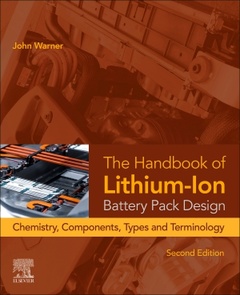Description
The Handbook of Lithium-Ion Battery Pack Design (2nd Ed.)
Chemistry, Components, Types, and Terminology
Author: Warner John T.
Language: English
Subjects for The Handbook of Lithium-Ion Battery Pack Design:
Keywords
Lithium; battery; Ion; Lithium Ion; EV Battery; Battery Pack; automobile; BEV; PHEV; HEV; manufacturing; battery design; Abuse; Acronyms; Advanced lithium-ion; Air cooling; Battery; Battery design; Battery management system; BMS; CAD; CAE; CARB; Cells; Certification; CFD; Chemistry; Computational fluid dynamics; Computer-aided drafting; Computer-aided engineering; Concept; Contactors; Controls; Definitions; Design; Design for reliability; Design for service; DVP&; R; Electric vehicle; Electric vehicles; Electrification; Engineering; EV; Failure modes effects analysis; Formula; Fuse; Heat exchangers; High-voltage front end; High-voltage interlock loop; History; HVFE; HVIL; Ingress protection; International electrotechnical commission (IEC); International organization for standardization (ISO); LFP; Li-ion; Li-polymer; Liquid cooling; Lithium-ion; Lithium-ion applications; LMO; LTO; Lumped parameter model; Mandatory standards; Manual service disconnect; Markets; Mechanical structure; Mid-pack disconnect; Module; NMC; Pack; Packaging; PCB; Population; Quality; Rechargeable; Recycling; Remanufacturing; Repair; Repurposing; Residual value; Second life; Secondary batteries; Silicon; Society of automotive engineers (SAE); Technological trends; Temperature measurement; Terminology; Testing; Thermal management system; Thermistor; Tin; TMS; Underwriters laboratory (UL); Validation; Voluntary standards; Battery Fundamentals; Sodium-Ion; EV Charging; Pack Manufacturing: Module Manufacturing: Cell Manufacturing: Thermal Runaway: Cascading Failure
352 p. · 19x23.3 cm · Paperback
Description
/li>Contents
/li>Biography
/li>Comment
/li>
The Handbook of Lithium-Ion Battery Pack Design: Chemistry, Components, Types, and Terminology, Second Edition, provides a clear and concise explanation of EV and Li-ion batteries for readers that are new to the field. The second edition expands and updates all topics covered in the original book, adding more details to all existing chapters, and including major updates to align with all the rapid changes the industry has experienced over the past few years. The second edition adds two new chapters; the first delves into the processes of module and pack manufacturing, while the second introduces topics that are adjacent to the battery such as charging infrastructure, battery swapping, and charging as a service. This handbook offers a layman’s explanation of the battery industry and technology, including the history of vehicle electrification and battery technology, describing the various terminologies and acronyms, and explaining how to do simple calculations that can be used in determining basic battery sizing, capacity, voltage, and energy. By the end of reading this book, the reader will have a solid understanding of the terminology around Li-ion batteries and be able to undertake simple battery calculations. This book is immensely useful to both beginning and experienced engineers alike. The Handbook of Lithium-Ion Battery Pack Design: Chemistry, Components, Types, and Terminology, Second Edition is a reference tool for anyone that is transitioning into the battery industry. Whether you are an electrical or mechanical engineer, chemist, purchasing, sales, executive, or government, it will help you better appreciate the interrelationships between the various battery engineering fields that are required to understand the battery as an Energy Storage System.
1. Introduction 2. History of Vehicle Electrification 3. Basic Terminology 4. Battery Pack Design 5. Design for Reliability 7. Lithium-Ion and Other Cell Chemistries 8. Battery Management 9. System Control Electronics 10. Thermal Management 11. Mechanical Packaging and Material Selection 12. Cell, Module and Pack Manufacturing 13. Battery Abuse Tolerance Failure Modes of Lithium-Ion Batteries 14. Industrial Standards and Organizations 15. Charging and Batteries as a Service 16. Second Life and Recycling of Lithium-Ion Batteries 17. Lithium-Ion Battery Applications 18. The Future of Lithium-Ion Batteries and Electrification
Adds a brief history of battery technology and its evolution to current technologies?
Expands and updates the chemistry to include the latest types
Discusses thermal runaway and cascading failure mitigation technologies?
Expands and updates the descriptions of the battery module and pack components and systems??
Adds description of the manufacturing processes for cells, modules, and packs?
Introduces and discusses new topics such as battery-as-a-service, cell to pack and cell to chassis designs, and wireless BMS?



